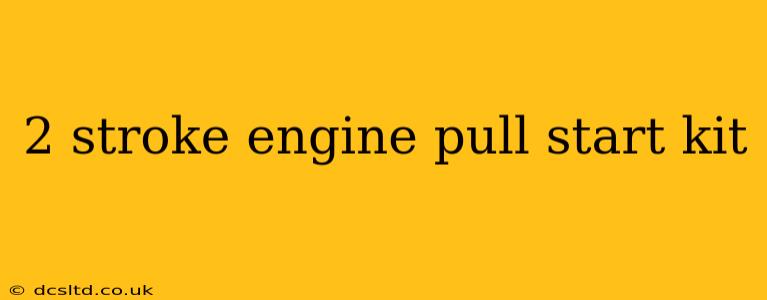Finding the right pull start kit for your 2-stroke engine can feel overwhelming. This guide breaks down everything you need to know, from understanding different types of kits to troubleshooting common issues and ensuring a smooth, reliable start every time. We'll cover essential components, installation tips, and answer frequently asked questions to help you get your engine running smoothly.
What is a 2-Stroke Engine Pull Start Kit?
A 2-stroke engine pull start kit is a replacement or upgrade assembly that allows you to manually start your engine using a rope. It's a crucial component for many small engines found in chainsaws, weed whackers, generators, and other power equipment. The kit typically includes the starter rope, recoil starter assembly (the housing containing the spring and mechanism), and potentially other components like a starter pawl or spring.
What are the Different Types of 2-Stroke Engine Pull Start Kits?
Pull start kits aren't one-size-fits-all. They vary depending on the engine's make, model, and size. Key differences include:
- Engine Specific Kits: These kits are designed for a particular engine model and will guarantee compatibility. The part number is crucial here.
- Universal Kits: These kits might claim broader compatibility but often require some modification or adaptation to fit perfectly. Carefully check dimensions and specifications before purchasing.
- Upgrade Kits: Some kits offer improved components, such as stronger springs or enhanced rope material, for improved durability and longevity.
How Do I Choose the Right 2-Stroke Engine Pull Start Kit?
Choosing the correct kit hinges on precise identification of your engine. Look for the following information:
- Engine Model Number: This is usually found on a sticker on the engine itself.
- Engine Manufacturer: Knowing the brand (e.g., Briggs & Stratton, Honda, etc.) narrows down the possibilities.
- Measurements: Compare dimensions of your existing pull start assembly with the specifications of the kit you’re considering.
Never assume compatibility based on visual similarity alone. Slight differences in dimensions can render a kit unusable.
How to Install a 2-Stroke Engine Pull Start Kit?
Installation varies depending on the engine and kit design, but generally involves these steps:
- Disassembly: Carefully remove the old pull start assembly. Take photos or make notes to aid reassembly.
- Component Inspection: Examine the new kit for any included instructions or diagrams.
- Installation: Fit the new assembly, ensuring proper alignment and secure fastening of all components.
- Testing: Carefully pull the starter rope to check for smooth operation and proper engagement with the engine’s flywheel.
What are Common Problems with 2-Stroke Engine Pull Start Kits?
Several issues can arise:
- Broken Starter Rope: This is the most common problem and usually requires replacing just the rope.
- Weak Recoil Spring: A weakened spring results in difficult starting. You might need to replace the entire assembly or just the spring itself.
- Stripped Gears: This is often caused by excessive force when pulling the rope or wear and tear. A complete kit replacement may be needed.
- Incorrect Installation: Improper installation can lead to malfunctions. Double-check all connections and alignments.
What are the Symptoms of a Bad 2-Stroke Engine Pull Start Kit?
- Difficult Starting: The engine is hard to pull over, requiring excessive force.
- Rope Breaks Easily: The rope snaps frequently during use.
- Rope Feels Loose or Slips: The rope doesn't engage properly with the starter mechanism.
- No Response When Pulling: The rope pulls freely without engaging the engine.
Where Can I Find Replacement Parts for My Pull Start Kit?
Replacement parts, including ropes and springs, are often available from online retailers like Amazon or eBay, or from local small engine repair shops. Always specify your engine model number for accurate part identification.
This guide offers a comprehensive overview, but always consult your engine's specific manual for detailed instructions. Remember safety precautions when working with engines and tools. If unsure about any repair, it's always best to consult a professional.
